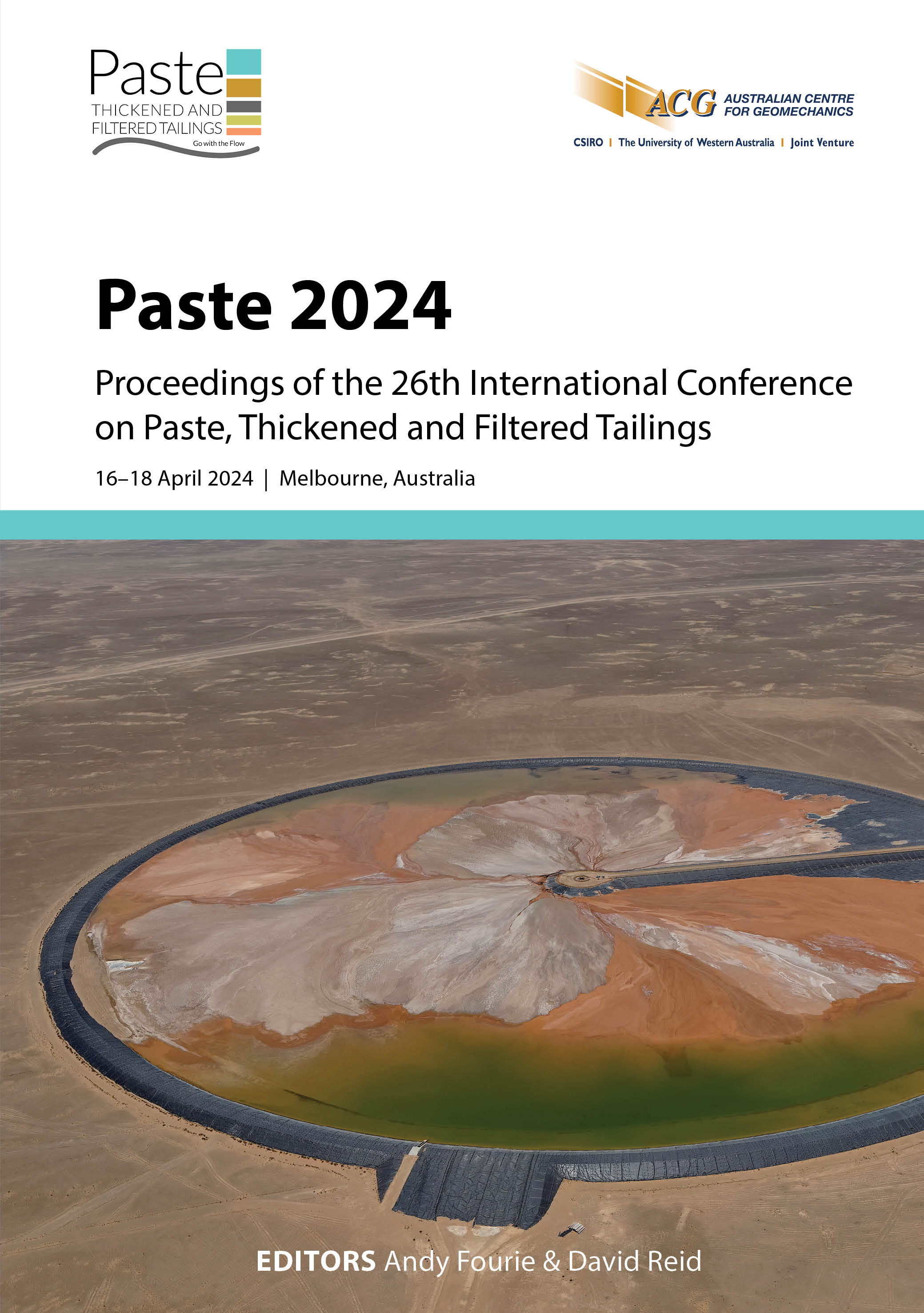Monitoring bed formation in a pipeline: a comparative study of two measurement methods

|
Authors: Chryss, AG; Zheng, E |
DOI https://doi.org/10.36487/ACG_repo/2455_34
Cite As:
Chryss, AG & Zheng, E 2024, 'Monitoring bed formation in a pipeline: a comparative study of two measurement methods', in AB Fourie & D Reid (eds), Paste 2024: Proceedings of the 26th International Conference on Paste, Thickened and Filtered Tailings, Australian Centre for Geomechanics, Perth, pp. 431-440, https://doi.org/10.36487/ACG_repo/2455_34
Abstract:
Transport of tailings via pipeline is a common practice between mineral processing sites and a tailings storage facility. To operate these typically turbulent multiphase-flows safely at high solids loadings with minimum energy and water consumption is not a simple task. Monitoring of tailings pipelines is often restricted to pressure drop measurements. Monitoring could be enhanced by effective, non-radiometric instrumentation for solids concentration or concentration profile. Two possible options for such an instrument are electrical resistance tomography (ERT) and thermal bed load detection (BLD). ERT represents a non-intrusive method suitable for monitoring solid-liquid suspension flows. While ERT has shown its capability to generate good qualitative images, it faces challenges including limited spatial resolution, sensitivity to electric noise and the inherent difficulty of calculating concentration distributions. For suspensions with a settled bed, ERT reconstruction projects an incorrect smooth transition at the bed interface and typically underestimates the concentration, with a discrepancy up to 25% (v/v) at the highest bed level. Thermal BLD provides a method of measuring the depth of a settled bed via changes in rate of heat transfer. The BLD consists of multiple sensors around the pipe circumference which combine a heater with a thermocouple to maintain a constant surface temperature. The power required to maintain a set temperature is proportional to the heat lost to the fluid or bed that is in contact with the sensor. The change in rate of heat transfer is then used to infer bed depth. A comparison is made between the results from both methods at laboratory and pilot scales. The data is assessed for its accuracy and the robustness of measurements for field deployment.
Keywords: solids settling, pipeline transport, electrical resistance tomography, thickened tailings, settled bed
References:
Eskin, D 2012, ‘A simple model of particle diffusivity in horizontal hydrotransport pipelines’, Chemical Engineering Science, vol. 82, pp. 84–94.
Gillies, R & Shook, C 1994, ‘Concentration distributions of sand slurries in horizontal pipe flow’, Particulate Science Technology, vol. 12. no. 1, pp. 45–69.
Hashemi, S, Spelay, R, Sanders, R & Hjertaker, B 2021, ‘A novel method to improve electrical resistance tomography measurements on slurries containing clays’, Flow Measurement and Instrumentation, vol. 80, pp. 101973.
Industrial Tomography Systems 2009, ITS System 2000 Version 7.0 p2+ Electrical Resistance Tomography System - User’s Manual.
Oroskar, R & Turian, M 1980, ‘The critical velocity in pipeline flow of slurries’, AIChE Journal, vol. 26, pp. 550–558.
Polydorides, N 2002, Image Reconstruction Algorithms for Soft-Field Tomography, PhD thesis, University of Manchester Institute of Science and Technology, Manchester.
Sharifi, M & Young, B 2013, ‘Electrical resistance tomography (ERT) applications to chemical engineering’, Chemical Engineering Research Design, vol. 91, no. 9, pp. 1625–1645.
Shokri, R, Ghaemi, S, Nobes, D & Sanders, R 2017, ‘Investigation of particle-laden turbulent pipe flow at high-Reynolds-number using particle image/tracking velocimetry (PIV/PTV)’, International journal of multiphase flow, vol. 89, pp. 136–149.
Silva, R 2015, Solid/Liquid Suspension Flow in Pipes: Modelling and Experimental Investigation, PhD thesis, Universidade de Coimbra, Coimbra.
© Copyright 2025, Australian Centre for Geomechanics (ACG), The University of Western Australia. All rights reserved.
View copyright/legal information
Please direct any queries or error reports to repository-acg@uwa.edu.au
View copyright/legal information
Please direct any queries or error reports to repository-acg@uwa.edu.au
